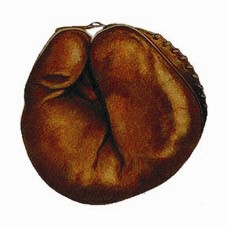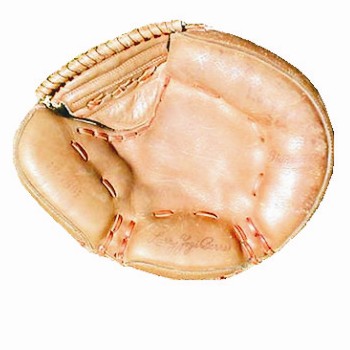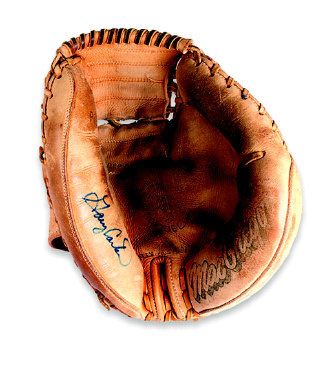|
| ||||||
|
| ||||||
| HISTORY | MITTS | MASKS | SHIN GUARDS | CHEST | MISC | SIZING |
|
| ||||||
Mitts were a taken-for-granted part of catching. The earliest documented use of a glove by any player occurred on June 28, 1870 and that was by a catcher. A sportswriter for the Cincinnati Commercial cabled his office "[Doug] Allison caught today in a pair of buckskin mittens, to protect his hands." It was printed in the next day's newspaper in a recap of the Cincinnati Red Stockings versus the Washington Nationals in D.C.
 1883 |
 1905 |
 1920 |
 1930 |
Gloves then masks came into use in the 1870's. At first players had to skulk onto the field. But, star pitcher, turned first baseman, Albert Spalding made it a manly thing in 1877, boldly donning a black glove that was fingerless, but padded. Ever the entrepreneur, Spalding envisioned big sales for his mail-order sporting goods business. Catchers were among his best customers.
 1940 |
 1950 |
 1970 |
 1990 |
By 1890, ex-catcher Harry Decker had patented the "Decker Safety Catcher's Mitt," a contraption that was basically a glove stitched to the back of a round pad that covered the palm of the hand. These gloves were literally flat pillows that got their pockets broken in on the job–at the expense of the catcher's palm.
Historians quibble over whether Harry Decker or Joe Gunson first used the padded catcher's mitt in the 1880's. Supposedly, Kansas City Cowboy's Gunson dreamed up the mitt, but he was too busy catching in Al Spalding's world baseball tour to take advantage of the idea. So, Decker filed a patent on the now-familiar mitt design in 1889.
It was not until 1895 that stipulations concerning use of gloves were included in the rules: those limited the size of gloves to ten ounces and fourteen inches circumference for all players except catchers and first basemen, who were permitted to use any size glove. The early gloves, lacking webbing and lacing, merely provided protection for the hands. Players in the 19th Century often wore gloves on both hands. For the throwing hand, they would simply snip the glove at the fingers for dexterity.
 2000s |
"They were still pretty small, flat and had no shape when I came into the big leagues in 1937," recalls former Brooklyn Dodger catcher Mickey Owen, who turns 77 this year.
"A fellow from Rawlings came in one day, Harry Latina, asked us a lot of questions and said he could build a better mitt. And he did, "Owen tells PM. Harry "Bud" Latina, the legendary "glove doctor," was Rawlings chief designer for four decades. "He made a real change in the depth of the mitt so the ball would really stick," says Owen.
According to Owen, Latina's innovations made catching easier, but you still had to use two hands. Modern mitts, he contends, have evolved to match today's style of baseball.
"Catchers now have to one-hand or backhand the ball," he points out. "They have to work much lower than we did because the pitching's low now– at or below the batter's knees. When you're catching that low you can't hold two hands or even one with the fingers pointing up and parallel to your body."
Catcher Earl Battey, a 3-time Gold Glove winner, notes that mitts have changed substantially even since he was battery mate with Gold Glover Jim Kaat on the Minnesota Twins in the 1960s.
"Today's mitts have multiple breaks and a long oval pocket, more like a first baseman's," says Battey. "When I played, we had a pocket but no breaks, and we caught two-handed so the ball wouldn't pop out." One-handed catching became possible with the hinged mitt, popularized by Johnny Bench and Randy Hundley in the late 1960s. With these, a spring-action hinge snaps the mitt closed on contact with the ball.
The ancestry of the flex-hinge catcher's mitt goes back to the first baseman's mitts of the 1950's. Logically one might suppose that former first basemen (like Bob Tillman or J.C. Martin), converted to catchers in large numbers in the early 1960's, would have been the ones to introduce the mitt. But in fact, the flex-hinge catcher's mitt was introduced by Randy Hundley in 1966 and Johnny Bench in 1968, neither of whom had ever played first base.
Not every development meets with acceptance, of course. Neither Owen nor Battey think much of another innovation in catcher's mitts–the oversized "Big Bertha" designed by Baltimore Orioles manager Paul Richards in the late '50's to help his receivers handle the maddening knuckleball of Hoyt Wilhelm. Such baskets grew to a 45-in. circumference before being regulated to 38 in. in '65.
"The surface area might help you knock down the ball, but it hinders your view and cuts down your hand mobility," says Battey.
Owen, who, by his own description, "boxed" with a few knucklers, notes another consideration.
"Even if you catch the ball in that glove, it's hard to find it in time to catch base-stealers."
Owen, fittingly, is keenly interested in the latest wrinkle in mitts, a "digital leather" glove made by Franklin. The innovation is already found in Franklin's current line of fielders' gloves and will make its debut in catchers' mitts this August. The facing leather is etched with a pattern of grooves and diamonds which has a two-fold purpose. First, the pattern absorbs the shock of impact. Then, its contours grab the ball and stop its spinning action.
Both attributes might turn some hard-hands into soft ones. Webbing, air or gel cushions and other elements of glove design have dealt with the velocity of batted and pitched balls, but only lately have manufacturers turned their attention to the spin factor. The rotation on a baseball can be quite high–1800 rpm or more on a curveball, for example. Franklin likens its digital leather to the road-gripping pattern of a tire.
That leaves the near-spinless knuckleball to contend with–a problem sure to compound as more hurlers follow 1992's pitching phenom, knuckler Tim Wakefield of the Pittsburgh Pirates. What do you do when glove technology is of little help?
"You just have to box with it," advises Earl Battey.
